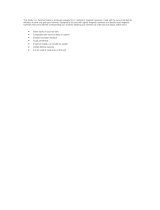Page
CONTENTS
[ Business Section ]
1. PRODUCT NAME
••••••••••••••••••••••••••••••••••••••••••••••••••••••••••••••••••••••••••••••••••••••••••••••••••••••••••••••••••••••
1
2. MARKETING OBJECTIVE
•••••••••••••••••••••••••••••••••••••••••••••••••••••••••••••••••••••••••••••••••••••••••••••••••••••••••
1
3. APPLICATIONS
•••••••••••••••••••••••••••••••••••••••••••••••••••••••••••••••••••••••••••••••••••••••••••••••••••••••••••••••••••••••••
1
4. SELLING POINTS
••••••••••••••••••••••••••••••••••••••••••••••••••••••••••••••••••••••••••••••••••••••••••••••••••••••••••••••••••••••
1
4-1. Selling Point Descriptions
••••••••••••••••••••••••••••••••••••••••••••••••••••••••••••••••••••••••••••••••••••••••••••••••••••••
2
5. SPECIFICATIONS
••••••••••••••••••••••••••••••••••••••••••••••••••••••••••••••••••••••••••••••••••••••••••••••••••••••••••••••••••••••
4
5-1. Specifications
•••••••••••••••••••••••••••••••••••••••••••••••••••••••••••••••••••••••••••••••••••••••••••••••••••••••••••••••••••••••
4
5-2. Standard Accessories
•••••••••••••••••••••••••••••••••••••••••••••••••••••••••••••••••••••••••••••••••••••••••••••••••••••••••••
4
5-3. Optional Accessories
••••••••••••••••••••••••••••••••••••••••••••••••••••••••••••••••••••••••••••••••••••••••••••••••••••••••••••
5
6. COMPARISONS WITH SIMILAR PRODUCTS
•••••••••••••••••••••••••••••••••••••••••••••••••••••••••••••••••••••••••••
6
6-1. Specification Comparisons
••••••••••••••••••••••••••••••••••••••••••••••••••••••••••••••••••••••••••••••••••••••••••••••••••••
6
6-2. Characteristics Comparisons
•••••••••••••••••••••••••••••••••••••••••••••••••••••••••••••••••••••••••••••••••••••••••••••••••
6
7. PRECAUTIONS IN SALES PROMOTION
••••••••••••••••••••••••••••••••••••••••••••••••••••••••••••••••••••••••••••••••••
7
7-1. Safety Instructions
••••••••••••••••••••••••••••••••••••••••••••••••••••••••••••••••••••••••••••••••••••••••••••••••••••••••••••••••
7
7-2. Precautions in Sales Promotion
•••••••••••••••••••••••••••••••••••••••••••••••••••••••••••••••••••••••••••••••••••••••••••••
7
[ Service Section ]
8. TROUBLESHOOTING
•••••••••••••••••••••••••••••••••••••••••••••••••••••••••••••••••••••••••••••••••••••••••••••••••••••••••••••••
10
8-1. Troubleshooting Guide
••••••••••••••••••••••••••••••••••••••••••••••••••••••••••••••••••••••••••••••••••••••••••••••••••••••••••
10
9. PRECAUTIONS IN DISASSEMBLY AND REASSEMBLY
••••••••••••••••••••••••••••••••••••••••••••••••••••••••••
12
9-1. Disassembly and Reassembly of the Feeder Unit and Handling Precautions
••••••••••••••••••••••••••••
12
9-1-1. Disassembly
•••••••••••••••••••••••••••••••••••••••••••••••••••••••••••••••••••••••••••••••••••••••••••••••••••••••••••••••••••
12
9-1-2. Reassembly
•••••••••••••••••••••••••••••••••••••••••••••••••••••••••••••••••••••••••••••••••••••••••••••••••••••••••••••••••••
12
9-1-3. Tightening Torque
•••••••••••••••••••••••••••••••••••••••••••••••••••••••••••••••••••••••••••••••••••••••••••••••••••••••••••
13
9-1-4. Confirmation After Reassembly
•••••••••••••••••••••••••••••••••••••••••••••••••••••••••••••••••••••••••••••••••••••••
13
9-2. Precautions in Disassembly and Reassembly of the Main Body
•••••••••••••••••••••••••••••••••••••••••••••••
13
9-2-1. Disassembly
•••••••••••••••••••••••••••••••••••••••••••••••••••••••••••••••••••••••••••••••••••••••••••••••••••••••••••••••••••
13
9-2-2. Reassembly
•••••••••••••••••••••••••••••••••••••••••••••••••••••••••••••••••••••••••••••••••••••••••••••••••••••••••••••••••••
15
9-2-3. Insulation Tests
•••••••••••••••••••••••••••••••••••••••••••••••••••••••••••••••••••••••••••••••••••••••••••••••••••••••••••••
20
9-2-4. No-load Current Value
••••••••••••••••••••••••••••••••••••••••••••••••••••••••••••••••••••••••••••••••••••••••••••••••••••
20
10. STANDARD REPAIR TIME (UNIT) SCHEDULES
•••••••••••••••••••••••••••••••••••••••••••••••••••••••••••••••••••••
21
[ Appendix ]
Assembly Diagram for WF 4V
••••••••••••••••••••••••••••••••••••••••••••••••••••••••••••••••••••••••••••••••••••••••••••••••••••••
22
Notice for use
Specifications and parts are subject to change for improvement.
Refer to Hitachi Power Tool Technical News for further information.






















